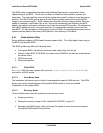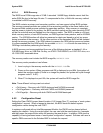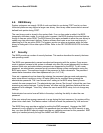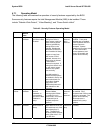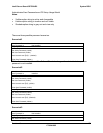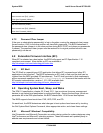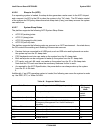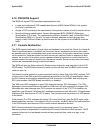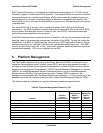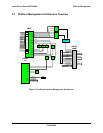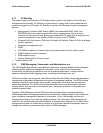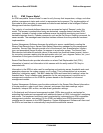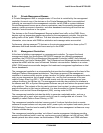
Intel® Server Board SE7520JR2 System BIOS
Revision 1.0
C78844-002
111
4.9.2.6 Sleep to On (ACPI)
If an operating system is loaded, the sleep button generates a wake event to the ACPI chipset
and a request (via SCI) to the OS to place the system in the “On” state. The OS retains control
of the system and OS policy determines what sleep state (if any) and sleep sources the system
can wake from.
4.9.2.7 System Sleep States
The platform supports the following ACPI System Sleep States:
• ACPI S0 (working) state
• ACPI S1 (sleep) state
• ACPI S4 (suspend to disk) state
• ACPI S5 (soft-off) state
The platform supports the following wake up sources in an ACPI environment. As noted above,
the OS controls the enabling and disabling of these wake sources.
• Devices that are connected to all USB ports, such as USB mice and keyboards can wake
the system up from the S1 sleep state.
• PS/2 keyboards and mice can wake up the system from the S1 sleep state.
• Both serial ports can be configured to wake up the system from the S1 sleep state.
• PCI cards, such as LAN cards, can wake up the system from the S1 or S4 sleep state.
Note that the PCI card must have the necessary hardware for this to work.
• As required by the ACPI Specification, the power button can always wake up the system
from the S1 or S4 state.
2.
Additionally, if an ACPI operating system is loaded, the following can cause the system to wake
up: the PME, RTC, or Wake-On-LAN.
Table 44: Supported Wake Events
Wake Event Supported via ACPI (by sleep state) Supported
Via Legacy
Wake
Power Button Always wakes system. Always
wakes
system
Ring indicate from Serial A Wakes from S1 and S4. Yes
Ring indicate from Serial B Wakes from S1 and S4. If Serial-B (COM2) is used for
Emergency Management Port, Serial-B wakeup is
disabled.
Yes
PME from PCI cards Wakes from S1 and S4. Yes
RTC Alarm Wakes from S1. Always wakes the system up from S4. No
Mouse Wakes from S1. No
Keyboard Wakes from S1. No
USB Wakes from S1. No



